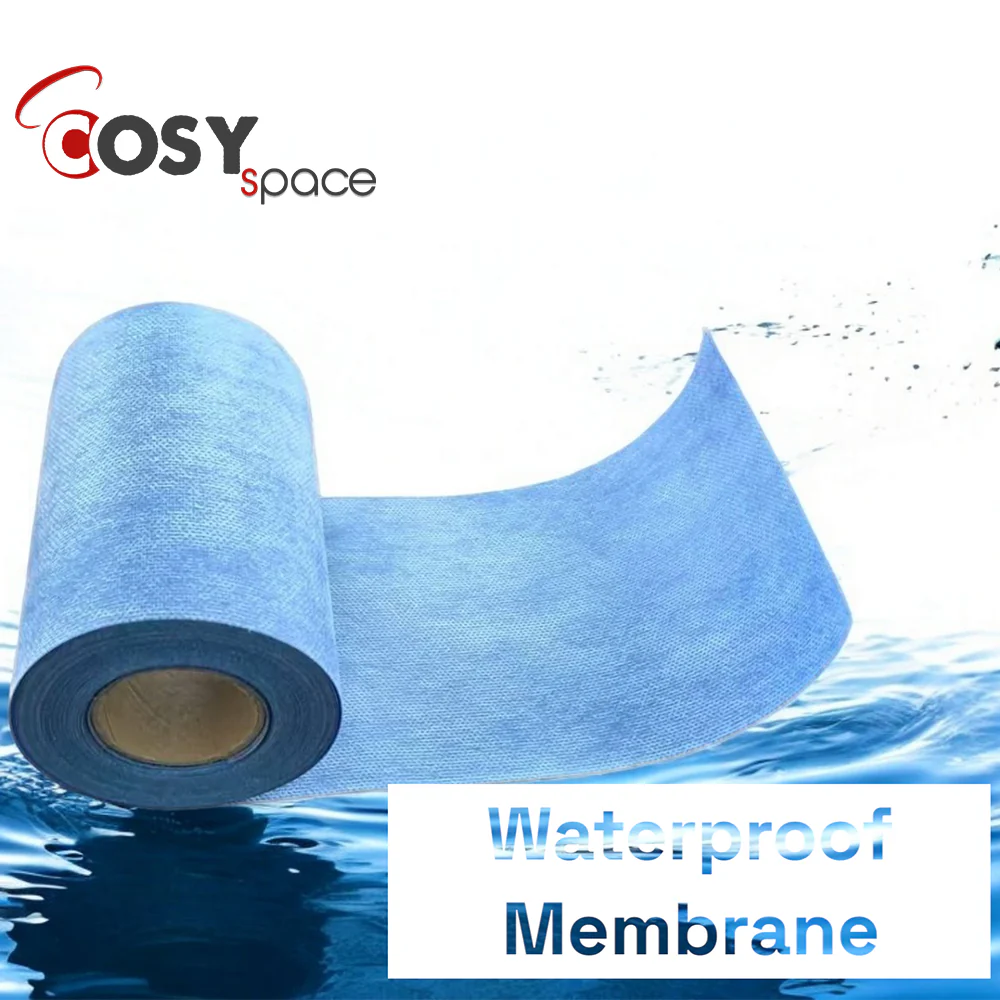Waterproof membranes are essential for safeguarding surfaces from moisture damage. They help maintain the integrity of high-risk areas such as bathrooms, basements, and outdoor spaces, where water exposure is common. Proper installation of waterproof membranes is crucial to avoid issues like water seepage, mold growth, and structural damage. When installed correctly, waterproof membranes create a reliable barrier that keeps water out and preserves your property. They provide long-lasting protection, ensuring that your home or building remains safe from moisture-related problems. Whether you are installing moisture barriers in a bathroom, basement, or outdoor area, following the correct procedure is key to ensuring their effectiveness. Let’s explore the detailed steps to properly install waterproof membranes and achieve optimal performance for your property’s protection.
Why Are Waterproof Membranes Important?
Waterproof membranes available at Cosyspace serve as a protective barrier, stopping water from seeping into surfaces. They are vital for preserving the structural integrity of buildings, particularly in areas exposed to moisture, like bathrooms, basements, and kitchens. Without a proper waterproofing solutions, water can penetrate surfaces, leading to serious damage. This can result in mold, mildew, and weakened foundations, which can be costly to repair. By installing waterproofing solutions, you ensure that moisture is kept at bay, protecting your home or building from water-related damage. Proper installation is crucial for maximum effectiveness and long-term durability of your structure.
Understanding the Importance of Waterproof Membranes in Construction
Waterproofing solutions are crucial for protecting surfaces from water and moisture damage. These membranes act as a barrier, preventing water from seeping into walls, floors, and ceilings. When installed properly, they ensure that structural components remain safe from water infiltration. If not installed correctly, water can penetrate these surfaces, leading to issues like mold, mildew, and eventual structural damage. This can weaken the integrity of your building, causing costly repairs. Waterproofing products are essential in maintaining the durability and safety of your property. They offer long-term protection, ensuring that water does not compromise your structure’s strength and longevity.
Tools and Materials Required for Installation
Before starting the installation, gather all the required materials and tools. Key items include a waterproofing application, primer, adhesive, utility knife, measuring tape, roller or brush for applying the membrane, and a high-quality sealant for sealing edges and joints. These tools are essential to ensure proper installation and achieve a seamless finish. Having everything ready before beginning the project helps to avoid delays and ensures the process goes smoothly. Proper preparation is the key to an efficient installation, preventing unnecessary interruptions and allowing for a quicker, more effective waterproofing job. Make sure to check that all tools are in good condition and ready for use.
Step 1: Preparing the Surface for Waterproof Membrane Application
Proper surface preparation is essential to ensure that the membrane adheres securely and effectively. Start by thoroughly cleaning the surface where the membrane will be applied, ensuring it is free of dirt, dust, grease, or old coatings. Any irregularities or cracks should be patched up to create a smooth and even surface for the membrane to bond with. Additionally, make sure the area is completely dry before starting the installation process, as moisture on the surface can interfere with the adhesion.
Step 2: Priming the Surface for Better Adhesion
Applying a primer to the surface before installing the membrane is a crucial step that should not be skipped. The primer helps to enhance the adhesion between the substrate and the membrane. Use a roller or brush to apply a thin, even layer of primer over the prepared surface, ensuring full coverage. Allow the primer to dry as instructed by the manufacturer’s guidelines. This process creates a stronger bond and guarantees that the membrane stays in place for years to come.
Step 3: Measuring and Cutting the waterproof Membranes to Fit
Accurate measurement and cutting are essential for a proper fit. Start by carefully measuring the dimensions of the area where the membrane will be applied. Once the measurements are taken, cut the membrane accordingly using a utility knife. Be sure to leave slight overlaps between the pieces to ensure no gaps in coverage. It’s essential that each piece fits snugly without any wrinkles or bubbles, which could lead to water infiltration.
Step 4: Installing the Waterproof Membranes on the Surface
The installation method will depend on the type of waterproofing applications you are using. If you are working with sheet membranes, apply the adhesive to the surface using a trowel or roller. Lay the membrane onto the adhesive, pressing down to ensure it adheres properly. Use a roller to smooth out any air bubbles or wrinkles. For liquid membranes, pour the liquid directly onto the surface and use a brush or roller to spread it evenly. Apply additional coats if necessary, allowing each layer to dry thoroughly before applying the next.
Step 5: Sealing Edges and Joints to Prevent Leaks
One of the most important steps in waterproof membrane installation is properly sealing the edges and joints. Gaps at these points can allow water to seep in, negating the effectiveness of the membrane. After the membrane is in place, use a high-quality sealant to cover any seams or joints, especially around corners, pipes, and other protrusions. This step ensures the surface is fully sealed and water-resistant.
Step 6: Allowing the waterproof Membranes to Cure Completely
Patience is key during the installation process. Once the membrane is in place, it needs to cure properly to achieve optimal performance. Allow the membrane to dry and cure according to the manufacturer’s instructions, ensuring it is fully set before using the area. Avoid walking on or placing any heavy objects on the membrane during this time, as it can disrupt the curing process and affect the adhesion.
Step 7: Performing a Leak Test to Ensure Effectiveness
Once the installation is complete and the waterproofing solutions has cured, it’s important to conduct a thorough leak test to verify the installation’s effectiveness. Pour water over the installed membrane and check for any areas where the water might seep through. If leaks are detected, take immediate action by applying additional sealant or adjusting the membrane as needed to eliminate the leaks. A successful leak test confirms that your waterproof membrane is working as intended.
Common Mistakes to Avoid During Installation Waterproof Membranes
There are several common mistakes that can compromise the effectiveness of your waterproof membrane installation. These include skipping the surface preparation, using incompatible adhesives or primers, applying the membrane too quickly without proper measurement, and neglecting the sealing of joints. Paying attention to each step and following the manufacturer’s guidelines carefully will help you avoid these pitfalls and ensure a high-quality installation.
Maintenance and Care for Long-lasting Results
After the waterproofing products have been installed, regular maintenance will ensure its longevity. Inspect the membrane periodically for signs of wear and tear, such as cracks or punctures. Keep the surface clean and free from debris to prevent damage. Reapply sealant to the edges as necessary and perform any repairs if you notice any issues. Consistent maintenance can extend the life of the waterproofing system and maintain its effectiveness over time.
Conclusion:
Installing a moisture barrier is an essential step in safeguarding your property from the harmful effects of water damage. Whether you’re working on a bathroom, basement, or outdoor area, taking the time to properly install a waterproof membrane ensures long-term durability and protection. By following the step-by-step guide provided—starting with thorough surface preparation, applying a suitable primer, and finishing with the right curing time—you’ll achieve a flawless waterproofing solution.
Remember, proper sealing of edges, careful measurements, and a detailed installation process are the key factors that make the difference between an effective and ineffective waterproof system. Additionally, maintaining the membrane through regular inspections and minor repairs will help you preserve its performance for years to come.
By avoiding common mistakes and adhering to manufacturer instructions, you can ensure that your waterproofing solutions work efficiently, offering peace of mind and protection against moisture damage. With the right care and attention to detail, your waterproofing system will provide lasting benefits, preventing costly repairs and enhancing the longevity of your structure.







Leave A Comment